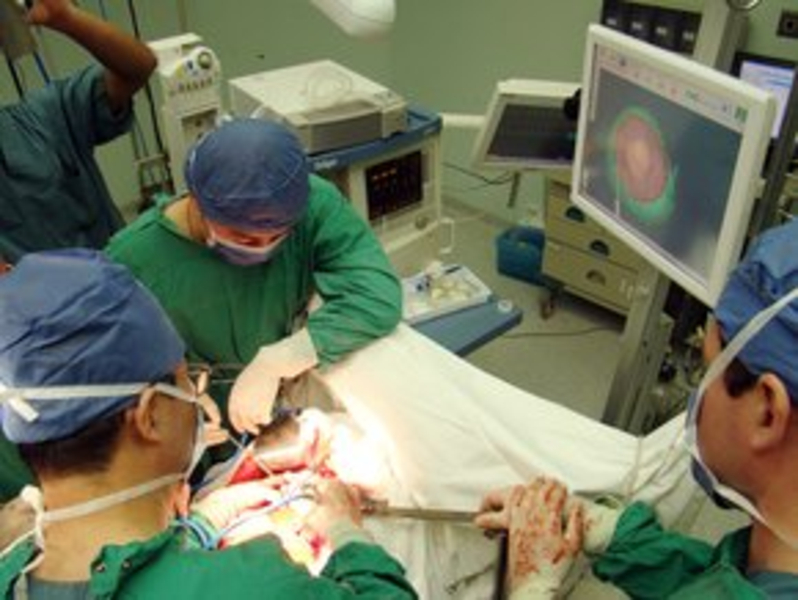Press Release

Today, challenging liver surgery is frequently planned and optimized with regard to associated risks with the support of a computer. Based on radiological image data, the liver vessels and tumors are analyzed to produce a patient-individual three-dimensional representation of the liver.
Prof. Wang (left) of the EHBH in Shanghai operates on a liver with the support of the navigation system. The position of the surgical instrument in the organ is continuously displayed on the screen. This helps the surgeon to orient themself and to improve accuracy and safety.
With the help of this virtual liver model, the surgeons can calculate the risks of a surgery and plan the optimal approach for the tumor resection.
In a research partnership between the Fraunhofer Institute for Medical Image Computing MEVIS in Bremen and the ARTORG Center for Biomedical Engineering Research at the University of Bern, this navigation technique will be intensively evaluated and developed further at the Eastern Hepatobiliary Surgery Hospital (EHBH) in Shanghai. Performing over 5,000 liver resections per year, the EHBH in Shanghai is the largest liver center in the world. Over 90% of the treated cases are primary liver tumors — so-called hepatocellular carcinomas (HCC) — which can be resected with a high probability of complete cure. The large number and wide scope of liver surgery cases at the EHBH allow both a clinical evaluation of the navigation support for these tumors in a relatively short amount of time and the incorporation of the results into the further development of the navigation system.
To initiate the research partnership, Prof. Heinz-Otto Peitgen and mathematician Andrea Schenk from Fraunhofer MEVIS in Bremen, Prof. Stefan Weber from ARTORG, and Prof. Daniel Candinas, head of visceral surgery and director of the Inselspital at the University of Bern, visited the EHBH in Shanghai from November 15 to 19, 2010. Under guidance of the liver surgeon Prof. Yi Wang and with support of the European guests, three patient operations were successfully performed with the liver navigation system produced by CAScination (Bern, Switzerland). Suggestions derived from the experiences collected in Shanghai are now integrated into the navigation system, and an updated system will be provided to the liver center in Shanghai for approximately one year.
Up until now, surgeons in the operating room (OR) have had to rely largely on their mentally conceptualized and memorized surgery plan, but modern navigation systems support the transfer of the preoperatively planned cutting line onto the patient’s liver directly in the OR. After registering the computer-generated individual model of the organ with the patient’s liver in the OR, the navigation system assists the surgeons to orient themselves in the complex network of the liver vessels and to identify the previously determined locations of high–risk structures. The current positions of the surgical instrument and the nearby blood vessels and tumors are continuously displayed on the screen. This provides the surgeons with a controlled realization of the previously planned optimal resection.
About ARTORG: The activities of the ARTORG research center, initiated in 2008 by the Inselspital (Medical Faculty) and the University of Bern, are centered around interdisciplinary teaching, research, and the development of biomedical technology. The Center brings together interdisciplinary research groups from the medical faculty as well as other faculties of the University of Bern and the Bern University of Applied Sciences.
 Fraunhofer Institute for Digital Medicine MEVIS
Fraunhofer Institute for Digital Medicine MEVIS